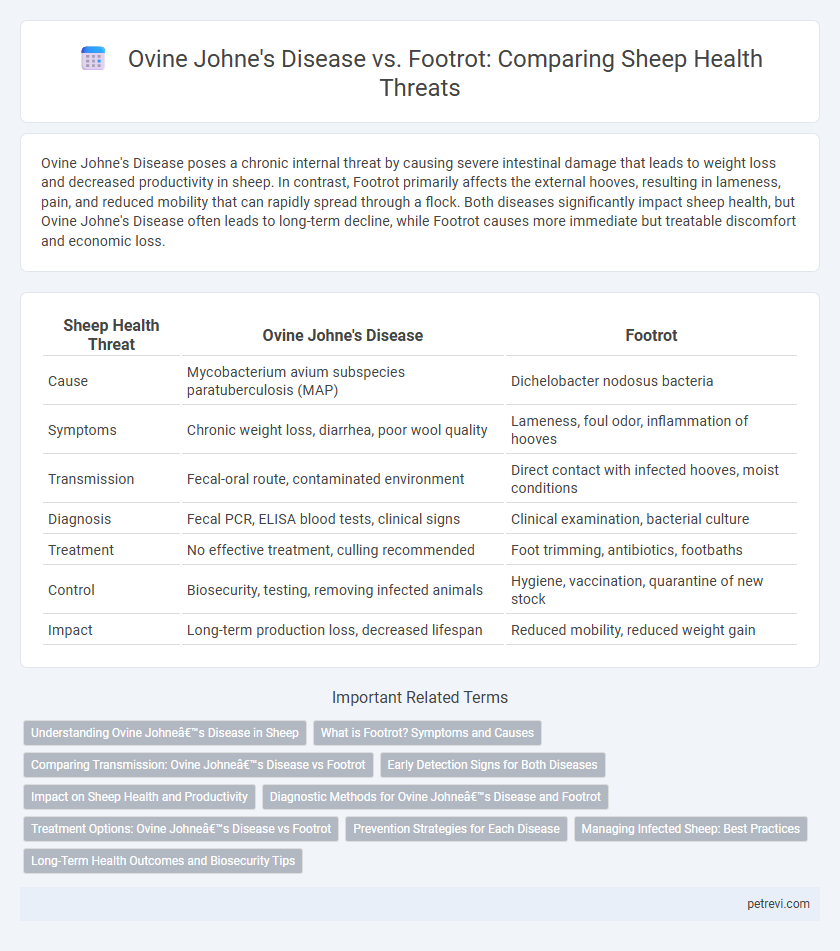Ovine Johne's Disease poses a chronic internal threat by causing severe intestinal damage that leads to weight loss and decreased productivity in sheep. In contrast, Footrot primarily affects the external hooves, resulting in lameness, pain, and reduced mobility that can rapidly spread through a flock. Both diseases significantly impact sheep health, but Ovine Johne's Disease often leads to long-term decline, while Footrot causes more immediate but treatable discomfort and economic loss.
Table of Comparison
| Sheep Health Threat | Ovine Johne's Disease | Footrot |
|---|---|---|
| Cause | Mycobacterium avium subspecies paratuberculosis (MAP) | Dichelobacter nodosus bacteria |
| Symptoms | Chronic weight loss, diarrhea, poor wool quality | Lameness, foul odor, inflammation of hooves |
| Transmission | Fecal-oral route, contaminated environment | Direct contact with infected hooves, moist conditions |
| Diagnosis | Fecal PCR, ELISA blood tests, clinical signs | Clinical examination, bacterial culture |
| Treatment | No effective treatment, culling recommended | Foot trimming, antibiotics, footbaths |
| Control | Biosecurity, testing, removing infected animals | Hygiene, vaccination, quarantine of new stock |
| Impact | Long-term production loss, decreased lifespan | Reduced mobility, reduced weight gain |
Understanding Ovine Johne’s Disease in Sheep
Ovine Johne's Disease, caused by Mycobacterium avium subspecies paratuberculosis, leads to chronic weight loss and diarrhea in sheep, posing a significant threat to flock health and productivity. Unlike Footrot, which primarily affects the hooves causing lameness, Ovine Johne's Disease impacts the intestines, resulting in long-term digestive issues and eventual mortality. Early detection through fecal culture or PCR testing is critical for managing the spread and mitigating economic losses in affected flocks.
What is Footrot? Symptoms and Causes
Footrot is a highly contagious bacterial infection affecting the hooves of sheep, primarily caused by the anaerobic bacteria Dichelobacter nodosus, often in conjunction with Fusobacterium necrophorum. Symptoms include lameness, foul-smelling discharge, inflammation, and separation of the hoof horn from the underlying tissue, leading to significant pain and mobility issues. Moist and muddy conditions facilitate the spread of footrot, making pasture management and hygiene critical in prevention and control.
Comparing Transmission: Ovine Johne’s Disease vs Footrot
Ovine Johne's Disease primarily spreads through the ingestion of contaminated feces, milk, or environmental materials, with infected adult sheep acting as carriers that shed the bacteria over extended periods. Footrot transmission occurs mainly via direct contact between infected and healthy sheep, facilitated by wet and muddy conditions that allow the bacteria to penetrate the hoof tissue. Understanding these distinct transmission routes is crucial for implementing targeted biosecurity measures to control the spread of each disease effectively.
Early Detection Signs for Both Diseases
Ovine Johne's Disease in sheep often presents early signs such as chronic weight loss and progressive diarrhea despite normal appetite, indicating intestinal infection. Footrot initially manifests as lameness, foul-smelling interdigital necrosis, and swollen feet, highlighting bacterial invasion in hoof tissues. Early identification of these distinct clinical symptoms is critical for timely intervention and reducing morbidity in affected flocks.
Impact on Sheep Health and Productivity
Ovine Johne's Disease causes chronic weight loss and reduced milk production, severely impacting sheep growth rates and overall productivity. Footrot leads to lameness, reduced grazing ability, and increased susceptibility to secondary infections, which decrease wool quality and weight gain. Both diseases significantly compromise sheep health, but Ovine Johne's Disease has a more prolonged effect on longevity and reproductive performance.
Diagnostic Methods for Ovine Johne’s Disease and Footrot
Ovine Johne's Disease diagnosis relies on advanced methods such as PCR testing, ELISA serology, and fecal culture to detect Mycobacterium avium subspecies paratuberculosis in sheep. Footrot diagnosis primarily involves clinical examination of interdigital skin lesions combined with bacterial culture or PCR to identify Dichelobacter nodosus strains. Accurate differentiation through molecular diagnostics ensures effective management and control of these distinct sheep health threats.
Treatment Options: Ovine Johne’s Disease vs Footrot
Ovine Johne's Disease requires long-term management with no effective treatment, focusing primarily on prevention through testing and culling infected animals to reduce disease spread. Footrot in sheep can be treated effectively with antibiotic therapy, footbaths, and regular hoof trimming to control infection and promote healing. Effective management of both diseases involves strict biosecurity and animal husbandry practices to maintain flock health.
Prevention Strategies for Each Disease
Effective prevention strategies for Ovine Johne's Disease include maintaining a closed flock, implementing rigorous testing programs, and ensuring proper sanitation to reduce exposure to contaminated environments. For footrot, regular hoof trimming, proper pasture management to minimize wet and muddy conditions, and timely use of footbaths with antiseptics are critical to controlling disease spread. Both diseases require early detection and biosecurity measures to safeguard overall sheep health and productivity.
Managing Infected Sheep: Best Practices
Managing infected sheep with Ovine Johne's Disease requires strict isolation of affected animals to prevent disease spread and careful monitoring of clinical signs such as weight loss and diarrhea. Footrot management focuses on regular hoof trimming, applying effective topical treatments, and maintaining dry, clean environments to reduce bacterial infection risks. Implementing comprehensive biosecurity measures and routine health assessments enhances early detection and control of both diseases, safeguarding overall flock health.
Long-Term Health Outcomes and Biosecurity Tips
Ovine Johne's Disease causes chronic wasting and severe intestinal damage, leading to long-term productivity loss and heightened culling rates in sheep flocks. Footrot primarily affects the hooves, causing lameness and impairing mobility, which can result in secondary infections if untreated but typically has less systemic impact. Implementing strict biosecurity measures, such as quarantine of new stock, regular hoof inspections, and maintaining clean pasture environments, is crucial to minimize the spread and economic impact of both diseases.
Ovine Johne’s Disease vs Footrot for Sheep Health Threat Infographic

 petrevi.com
petrevi.com